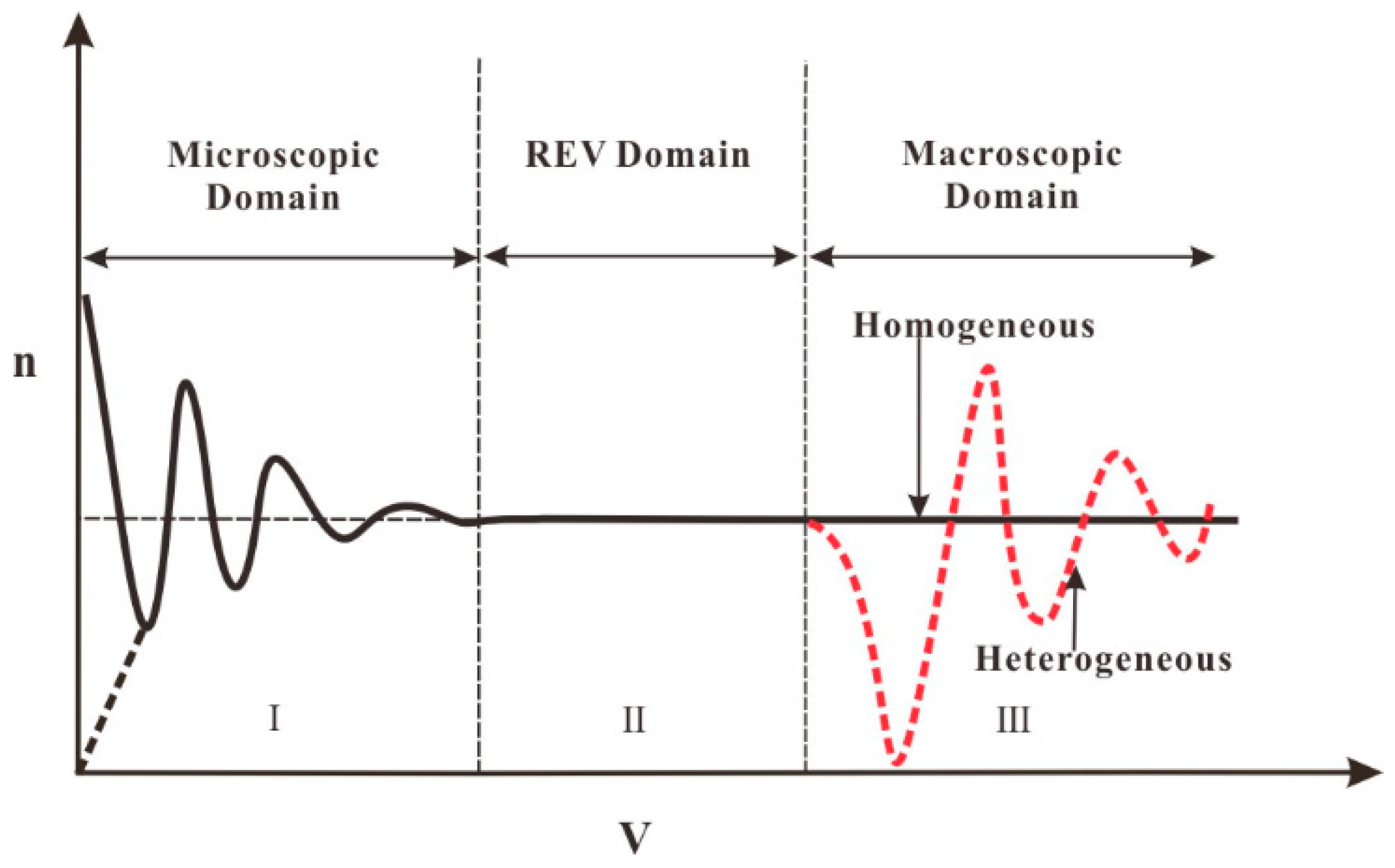Insights into Heterogeneity and Representative Elementary Volume of Vuggy Dolostones
Abstract
1. Introduction
2. Geological Setting
3. Samples and Methods
4. Quantitative Calculation of Parameters
4.1. Pore Geometrical Parameters
- (1)
- The dominant pore volume
- (2)
- The number of large vugs
- (3)
- Average shape factor
4.2. Heterogeneity Parameters
- (1)
- Coefficient of variation
- (2)
- Heterogeneous factor
4.3. Cyclicity of Porosity
5. Results
5.1. Rock Type
5.2. Pore System Classification
5.3. Quantified Pore Geometrical Parameters
5.4. Quantification of Heterogeneity
5.5. Cycle Analysis of Porosity
6. Discussion
6.1. Evaluation on Heterogeneity of Pore Systems
6.2. REV Analysis
6.3. The REV Prediction Model
7. Conclusions
- (1)
- A total of 26 vuggy dolostones collected from the Cambrian Xiaoerbulake Formation at the Kalping uplift are classified into four types of pore systems based on the pore size distribution and contribution of pores to porosity.
- (2)
- The different degrees of dissolution in different types of pore systems yield variation in porosity, pore structure parameters, and heterogeneity. The development of numerous vugs increases porosity and reduces heterogeneity, while the development of a small amounts of large vugs increases the sample’s heterogeneity.
- (3)
- The REV determined by the derivative of Cv_sub is more accurate than that determined by the cutoff value of Cv_sub. Only nine out of twenty-six samples have a DREV less than the volume of traditional core plugs (2.45 × 1013 μm3), hence the traditional core plugs are unrepresentative for most vuggy carbonate rocks.
- (4)
- The REV sizes are influenced by various factors. Any individual parameter only is inadequate to properly evaluate the REV sizes, so that multi-factors should be considered. A prediction model has been established based on the relationship between the REV sizes and the quantitative parameters of V50, , , , and H, with the correlation coefficient reaching 0.9320. Thus, our model could be very effective for predicting REV sizes of vuggy dolostones.
Author Contributions
Funding
Institutional Review Board Statement
Informed Consent Statement
Data Availability Statement
Acknowledgments
Conflicts of Interest
Nomenclature
| REV | the representative elementary volume |
| V50 | the dominant pore volume |
| the pore number on the cumulative curve at greater than 50% | |
| the average of the shape factor | |
| the area of the ith pore | |
| the volume of the ith pore | |
| n | the total number of pores |
| Cv | the coefficient of variation |
| the standard deviation | |
| the arithmetic mean value | |
| Cv_sli | the coefficient of variation of the medical-CT along the slice direction |
| Cv_sub | the coefficient of variation when determining the REV. |
| the heterogeneous factor | |
| the bulk volume of the sample | |
| the bulk volume of the inner large vugs of the sample (the volume of each vug is greater than or equal to V50) | |
| the volume of the sample, excluding | |
| the volume of the rock matrix | |
| the volume of pores, excluding | |
| the porosity of the sample | |
| the volume of the pores | |
| the porosity of the inner large vugs | |
| the porosity of the sample, excluding the inner large vugs | |
| the ratio of the bulk volume of the inner large vugs to the bulk volume of the sample | |
| the ratio of the porosity of the inner large vugs to the porosity of a sample excluding the inner large vugs | |
| the scale parameter (α > 0) | |
| the position parameter | |
| the signal | |
| the analyzing wavelet (the wavelet used is a complex wavelet) | |
| the number of periodicities per unit length | |
| P | the total number of periodicities |
| L | the number of CT slices |
| CREV | the determining REV based on the cutoff value of Cv_sli |
| DREV | the determining REV based on the derivative of Cv_sub |
| the characteristic length | |
| the number of spatial dimensions | |
| the median particle size | |
| the determined property | |
| the predicted property | |
| independent variables | |
| coefficients determined by the regression | |
| the adjusted coefficient of determination | |
| the sample size | |
| the total number of independent variables | |
| the determination coefficient |
References
- Ahr, W.M. Geology of Carbonate Reservoirs: The Identification, Description, and Characterization of Hydrocarbon Reservoirs in Carbonate Rocks; Wiley: Hoboken, NJ, USA, 2008. [Google Scholar] [CrossRef]
- Jia, C. Characteristics of Chinese Petroleum Geology: Geological Features and Exploration Cases of Stratigraphic, Foreland and Deep Formation Traps; Springer: Berlin/Heidelberg, Germany, 2012. [Google Scholar] [CrossRef]
- Bagrintseva, K.I. Carbonate Reservoir Rocks; John Wiley & Sons: Hoboken, NJ, USA, 2015. [Google Scholar]
- Apolinarska, K. Book Reviews. Origin of Carbonate Sedimentary Rocks; De Gruyter Open: Berlin, Germany, 2017. [Google Scholar] [CrossRef][Green Version]
- Issoufou Aboubacar, M.S.; Cai, Z. A Quadruple-Porosity Model for Consistent Petrophysical Evaluation of Naturally Fractured Vuggy Reservoirs. SPE J. 2020, 25, 2678–2693. [Google Scholar] [CrossRef]
- Zhang, H.; Ait Abderrahmane, H.; Arif, M.; Al Kobaisi, M.; Sassi, M. Influence of Heterogeneity on Carbonate Permeability Upscaling: A Renormalization Approach Coupled with the Pore Network Model. Energy Fuels 2022, 36, 3003–3015. [Google Scholar] [CrossRef]
- Gundogar, A.S.; Ross, C.M.; Akin, S.; Kovscek, A.R. Multiscale pore structure characterization of middle east carbonates. J. Pet. Sci. Eng. 2016, 146, 570–583. [Google Scholar] [CrossRef]
- Sadeghnejad, S.; Gostick, J. Multiscale Reconstruction of Vuggy Carbonates by Pore-Network Modeling and Image-Based Technique. SPE J. 2020, 25, 253–267. [Google Scholar] [CrossRef]
- Radwan, A.E.; Trippetta, F.; Kassem, A.A.; Kania, M. Multi-scale characterization of unconventional tight carbonate reservoir: Insights from October oil filed, Gulf of Suez rift basin, Egypt. J. Pet. Sci. Eng. 2021, 197, 107968. [Google Scholar] [CrossRef]
- Li, J.; Zhang, H.; Cai, Z.; Zou, H.; Hao, F.; Wang, G.; Li, P.; Zhang, Y.; He, J.; Fei, W. Making sense of pore systems and the diagenetic impacts in the Lower Triassic porous dolostones, northeast Sichuan Basin. J. Pet. Sci. Eng. 2021, 197, 107949. [Google Scholar] [CrossRef]
- Chen, J.; Yang, S.; Mei, Q.; Chen, J.; Chen, H.; Zou, C.; Li, J.; Yang, S. Influence of Pore Structure on Gas Flow and Recovery in Ultradeep Carbonate Gas Reservoirs at Multiple Scales. Energy Fuels 2021, 35, 3951–3971. [Google Scholar] [CrossRef]
- Jiang, Z.; van Dijke, M.I.J.; Sorbie, K.S.; Couples, G.D. Representation of multiscale heterogeneity via multiscale pore networks. Water Resour. Res. 2013, 49, 5437–5449. [Google Scholar] [CrossRef]
- Nader, F.H. Multi-Scale Quantitative Diagenesis and Impacts on Heterogeneity of Carbonate Reservoir Rocks; Springer: Berlin/Heidelberg, Germany, 2017. [Google Scholar]
- Frazer, G.W.; Wulder, M.A.; Niemann, K.O. Simulation and quantification of the fine-scale spatial pattern and heterogeneity of forest canopy structure: A lacunarity-based method designed for analysis of continuous canopy heights. For. Ecol. Manag. 2005, 214, 65–90. [Google Scholar] [CrossRef]
- Fitch, P.J.R.; Lovell, M.A.; Davies, S.J.; Pritchard, T.; Harvey, P.K. An integrated and quantitative approach to petrophysical heterogeneity. Mar. Pet. Geol. 2015, 63, 82–96. [Google Scholar] [CrossRef]
- Cooper, S.D.; Barmuta, L.; Sarnelle, O.; Kratz, K.; Diehl, S. Quantifying Spatial Heterogeneity in Streams. Freshw. Sci. 1997, 16, 174–188. [Google Scholar] [CrossRef]
- Tavakoli, V. Carbonate Reservoir Heterogeneity: Overcoming the Challenges; Springer International Publishing AG: Cham, Switzerland, 2019. [Google Scholar]
- Bear, J. Dynamics of Fluids in Porous Media; American Elsevier Publishing Company: Princeton, NJ, USA, 1972. [Google Scholar]
- Brown, G.O.; Hsieh, H.T.; Lucero, D.A. Evaluation of laboratory dolomite core sample size using representative elementary volume concepts. Water Resour. Res. 2000, 36, 1199–1207. [Google Scholar] [CrossRef]
- Rozenbaum, O.; du Roscoat, S.R. Representative elementary volume assessment of three-dimensional x-ray microtomography images of heterogeneous materials: Application to limestones. Phys. Rev. E 2014, 89, 053304. [Google Scholar] [CrossRef] [PubMed]
- Yio, M.H.N.; Wong, H.S.; Buenfeld, N.R. Representative elementary volume (REV) of cementitious materials from three-dimensional pore structure analysis. Cem. Concr. Res. 2017, 102, 187–202. [Google Scholar] [CrossRef]
- Shah, S.M.; Crawshaw, J.P.; Gray, F.; Yang, J.; Boek, E.S. Convex hull approach for determining rock representative elementary volume for multiple petrophysical parameters using pore-scale imaging and Lattice–Boltzmann modelling. Adv. Water Resour. 2017, 104, 65–75. [Google Scholar] [CrossRef]
- Wu, M.; Wu, J.; Wu, J. A three-dimensional model for quantification of the representative elementary volume of tortuosity in granular porous media. J. Hydrol. 2018, 557, 9. [Google Scholar] [CrossRef]
- Wang, Y.; Wang, L.; Wang, J.; Jiang, Z.; Wang, C.-C.; Fu, Y.; Song, Y.-F.; Wang, Y.; Liu, D.; Jin, C. Multiscale characterization of three-dimensional pore structures in a shale gas reservoir: A case study of the Longmaxi shale in Sichuan basin, China. J. Nat. Gas Sci. Eng. 2019, 66, 207–216. [Google Scholar] [CrossRef]
- Wu, H.; Yao, Y.; Zhou, Y.; Qiu, F. Analyses of representative elementary volume for coal using X-ray μ-CT and FIB-SEM and its application in permeability predication model. Fuel 2019, 254, 115563. [Google Scholar] [CrossRef]
- Vik, B.; Bastesen, E.; Skauge, A. Evaluation of representative elementary volume for a vuggy carbonate rock-Part: Porosity, permeability, and dispersivity. J. Pet. Sci. Eng. 2013, 112, 36–47. [Google Scholar] [CrossRef]
- Gonzalez, J.L.; de Faria, E.L.; Albuquerque, M.P.; Albuquerque, M.P.; Bom, C.R.; Freitas, J.C.C.; Cremasco, C.W.; Correia, M.D. Representative elementary volume for NMR simulations based on X-ray microtomography of sedimentary rock. J. Pet. Sci. Eng. 2018, 166, 906–912. [Google Scholar] [CrossRef]
- Singh, A.; Regenauer-Lieb, K.; Walsh, S.D.C.; Armstrong, R.T.; van Griethuysen, J.J.; Mostaghimi, P. On Representative Elementary Volumes of Grayscale Micro-CT Images of Porous Media. Geophys. Res. Lett. 2020, 47, e2020GL088594. [Google Scholar] [CrossRef]
- Shahin, G.; Desrues, J.; Pont, S.D.; Combe, G.; Argilaga, A. A study of the influence of REV variability in double-scale FEM × DEM analysis. Int. J. Numer. Methods Eng. 2016, 107, 882–900. [Google Scholar] [CrossRef]
- Norris, R.J.; Lewis, J.J.M. The Geological Modeling of Effective Permeability in Complex Heterolithic Facies. In Proceedings of the SPE Annual Technical Conference and Exhibition, SPE-22692-MS, Dallas, TX, USA, 6–9 October 1991. [Google Scholar] [CrossRef]
- Nordahl, K.; Ringrose, P.S. Identifying the Representative Elementary Volume for Permeability in Heterolithic Deposits Using Numerical Rock Models. Math. Geosci. 2008, 40, 753–771. [Google Scholar] [CrossRef]
- Katagiri, J.; Kimura, S.; Noda, S. Significance of shape factor on permeability anisotropy of sand: Representative elementary volume study for pore-scale analysis. Acta Geotech. 2020, 15, 2195–2203. [Google Scholar] [CrossRef]
- Borges, J.A.R.; Pires, L.F.; Cássaro, F.A.M.; Roque, W.L.; Heck, R.J.; Rosa, J.A.; Wolf, F.G. X-ray microtomography analysis of representative elementary volume (REV) of soil morphological and geometrical properties. Soil Tillage Res. 2018, 182, 112–122. [Google Scholar] [CrossRef]
- Razavi, M.R.; Muhunthan, B.; Al Hattamleh, O. Representative Elementary Volume Analysis of Sands Using X-Ray Computed Tomography. Geotech. Test. J. 2007, 30, 212–219. [Google Scholar] [CrossRef]
- Costanza-Robinson, M.S.; Estabrook, B.D.; Fouhey, D.F. Representative elementary volume estimation for porosity, moisture saturation, and air-water interfacial areas in unsaturated porous media: Data quality implications. Water Resour. Res. 2011, 47, W07513. [Google Scholar] [CrossRef]
- Al-Raoush, R.; Papadopoulos, A. Representative elementary volume analysis of porous media using X-ray computed tomography. Powder Technol. 2010, 200, 69–77. [Google Scholar] [CrossRef]
- Zhang, J.; Yu, L.; Jing, H.; Liu, R. Estimating the Effect of Fractal Dimension on Representative Elementary Volume of Randomly Distributed Rock Fracture Networks. Geofluids 2018, 2018, 1–13. [Google Scholar] [CrossRef]
- Wei, C.; Tian, C.; Zheng, J.; Cai, K.; Du, D.; Song, B.; Hu, Y. Heterogeneity Characteristics of Carbonate Reservoirs: A Case Study using Whole Core Data. In Proceedings of the SPE Reservoir Characterisation and Simulation Conference and Exhibition, Abu Dhabi, United Arab Emirates, 14–16 September 2015; p. D021S004R002. [Google Scholar] [CrossRef]
- Clausnitzer, V.; Hopmans, J.W. Determination of phase-volume fractions from tomographic measurements in two-phase systems. Adv. Water Resour. 1999, 22, 577–584. [Google Scholar] [CrossRef]
- Bažant, Z.P. Stochastic models for deformation and failure of quasibrittle structures: Recent advances and new directions. In Computational Modelling of Concrete Structures; A.A. Balkema Publisher: Lisse, The Netherlands, 2003; pp. 583–598. [Google Scholar]
- Bažant, Z.P.; Pijaudier-Cabot, G. Measurement of Characteristic Length of Nonlocal Continuum. J. Eng. Mech. 1989, 115, 755–767. [Google Scholar] [CrossRef]
- Lai, J.; Wang, G.; Wang, Z.; Chen, J.; Pang, X.; Wang, S.; Zhou, Z.; He, Z.; Qin, Z.; Fan, X. A review on pore structure characterization in tight sandstones. Earth-Sci. Rev. 2018, 177, 436–457. [Google Scholar] [CrossRef]
- Moslemipour, A.; Sadeghnejad, S. Dual-scale pore network reconstruction of vugular carbonates using multi-scale imaging techniques. Adv. Water Resour. 2021, 147, 103795. [Google Scholar] [CrossRef]
- Razavifar, M.; Mukhametdinova, A.; Nikooee, E.; Burukhin, A.; Rezaei, A.; Cheremisin, A.; Riazi, M. Rock Porous Structure Characterization: A Critical Assessment of Various State-of-the-Art Techniques. Transp. Porous Media 2021, 136, 431–456. [Google Scholar] [CrossRef]
- Vogel, H.J.; Weller, U.; Schlüter, S. Quantification of soil structure based on Minkowski functions. Comput. Geosci. 2010, 36, 1236–1245. [Google Scholar] [CrossRef]
- Cnudde, V.; Boone, M.N. High-resolution X-ray computed tomography in geosciences: A review of the current technology and applications. Earth-Sci. Rev. 2013, 123, 1–17. [Google Scholar] [CrossRef]
- Qajar, J.; Arns, C.H. Characterization of reactive flow-induced evolution of carbonate rocks using digital core analysis- part 1: Assessment of pore-scale mineral dissolution and deposition. J. Contam. Hydrol. 2016, 192, 60–86. [Google Scholar] [CrossRef] [PubMed]
- Chaves, J.M.; Moreno, R.B. Low- and High-Resolution X-Ray Tomography Helping on Petrophysics and Flow-Behavior Modeling. SPE J. 2021, 26, 206–219. [Google Scholar] [CrossRef]
- Pini, R.; Madonna, C. Moving across scales: A quantitative assessment of X-ray CT to measure the porosity of rocks. J. Porous Mater. 2015, 23, 325–338. [Google Scholar] [CrossRef]
- Ye, N.; Zhang, S.; Qing, H.; Li, Y.; Huang, Q.; Liu, D. Dolomitization and its impact on porosity development and preservation in the deeply burial Lower Ordovician carbonate rocks of Tarim Basin, NW China. J. Pet. Sci. Eng. 2019, 182, 106303. [Google Scholar] [CrossRef]
- Chen, L.; Zhang, H.; Cai, Z.; Hao, F.; Xue, Y.; Zhao, W. Petrographic, mineralogical and geochemical constraints on the fluid origin and multistage karstification of the Middle-Lower Ordovician carbonate reservoir, NW Tarim Basin, China. J. Petrol. Sci. Eng. 2022, 208, 109561. [Google Scholar] [CrossRef]
- Liu, P.X.; Deng, S.B.; Guan, P.; Jin, Y.Q.; Wang, K.; Chen, Y.Q. The nature, type, and origin of diagenetic fluids and their control on the evolving porosity of the Lower Cambrian Xiaoerbulak Formation dolostone, northwestern Tarim Basin, China. Pet. Sci. 2020, 17, 873–895. [Google Scholar] [CrossRef]
- Zhang, D.; Bao, Z.; Pan, W.; Hao, Y.; Cheng, Y.; Wang, J.; Zhang, Y.; Lai, H. Characteristics and forming mechanisms of evaporite platform dolomite reservoir in Middle Cambrian of Xiaoerbulake section, Tarim Basin. Nat. Gas Geosci. 2014, 25, 498–507. [Google Scholar]
- Deng, S.; Li, H.; Zhang, Z.; Zhang, J.; Yang, X. Structural characterization of intracratonic strike-slip faults in the central Tarim Basin. AAPG Bull. 2019, 103, 109–137. [Google Scholar] [CrossRef]
- Shen, A.; Zheng, J.; Chen, Y.; Ni, X.; Huang, L. Characteristics, origin and distribution of dolomite reservoirs in Lower-Middle Cambrian, Tarim Basin, NW China. Pet. Explor. Dev. 2016, 43, 375–385. [Google Scholar] [CrossRef]
- Zheng, J.P.; Wenqing, P.; Anjiang, S. Reservoir geological modeling and significance of Cambrian Xiaoerblak Formation in Keping outcrop area, Tarim Basin, NW China. Pet. Explor. Dev. 2019, 47, 392–402. [Google Scholar] [CrossRef]
- Zhang, J.; Song, A. Application of Wavelet Analysis in Sequence Stratigraphic Division of Glutenite Sediments. In Proceedings of the 2010 International Conference on Challenges in Environmental Science and Computer Engineering, Wuhan, China, 6–7 March 2010. [Google Scholar]
- Kadkhodaie, A.; Rezaee, R. Intelligent sequence stratigraphy through a wavelet-based decomposition of well log data. J. Nat. Gas Sci. Eng. 2017, 40, 38–50. [Google Scholar] [CrossRef]
- Allshorn, S.L.; Dawe, R.A.; Grattoni, C.A. Implication of heterogeneities on core porosity measurements. J. Pet. Sci. Eng. 2019, 174, 486–494. [Google Scholar] [CrossRef]
- Ostoja-Starzewski, M. Material spatial randomness: From statistical to representative volume element. Probabilistic Eng. Mech. 2006, 21, 112–132. [Google Scholar] [CrossRef]
- Gitman, I.M.; Askes, H.; Sluys, L.J. Representative volume: Existence and size determination. Eng. Fract. Mech. 2007, 74, 2518–2534. [Google Scholar] [CrossRef]
- Archie, G.E. Classification of Carbonate Reservoir Rocks and Petrophysical Considerations. AAPG Bull. 1952, 36, 278–298. [Google Scholar]
- Choquette, P.W.; Pray, L.C. Geologic Nomenclature and Classification of Porosity in Sedimentary Carbonates. AAPG Bull. 1970, 54, 207–250. [Google Scholar]
- Lønøy, A. Making sense of carbonate pore systems. AAPG Bull. 2006, 90, 1381–1405. [Google Scholar] [CrossRef]
- Lucia, F.J. Petrophysical Parameters Estimated From Visual Descriptions of Carbonate Rocks: A Field Classification of Carbonate Pore Space. J. Pet. Technol. 1983, 35, 629–637. [Google Scholar] [CrossRef]
- Lucia, F.J. Rock-Fabric/Petrophysical Classification of Carbonate Pore Space for Reservoir Characterization1. AAPG Bull. 1995, 79, 1275–1300. [Google Scholar]
- Lucia, F.J. Carbonate Reservoir Characterization; Springer: Berlin/Heidelberg, Germany, 2007. [Google Scholar] [CrossRef]
- Luo, P.; Machel, H.G. Pore size and pore throat types in a heterogeneous dolostone reservoir, Devonian Grosmont Formation, Western Canada sedimentary basin. AAPG Bull. 1995, 79, 1698–1720. [Google Scholar]
- Li, B.; Tan, X.; Wang, F.; Lian, P.; Gao, W.; Li, Y. Fracture and vug characterization and carbonate rock type automatic classification using X-ray CT images. J. Pet. Sci. Eng. 2017, 153, 88–96. [Google Scholar] [CrossRef]
- Archilla, N.L.; Missagia, R.M.; Hollis, C.; de Ceia, M.A.R.; McDonald, S.A.; Lima Neto, I.A.; Eastwood, D.S.; Lee, P. Permeability and acoustic velocity controlling factors determined from x-ray tomography images of carbonate rocks. AAPG Bull. 2016, 100, 1289–1309. [Google Scholar] [CrossRef]
- Oliveira, G.L.P.; Ceia, M.A.R.; Missagia, R.M.; Lima Neto, I.; Santos, V.H.; Paranhos, R. Core plug and 2D/3D-image integrated analysis for improving permeability estimation based on the differences between micro- and macroporosity in Middle East carbonate rocks. J. Pet. Sci. Eng. 2020, 193, 107335. [Google Scholar] [CrossRef]
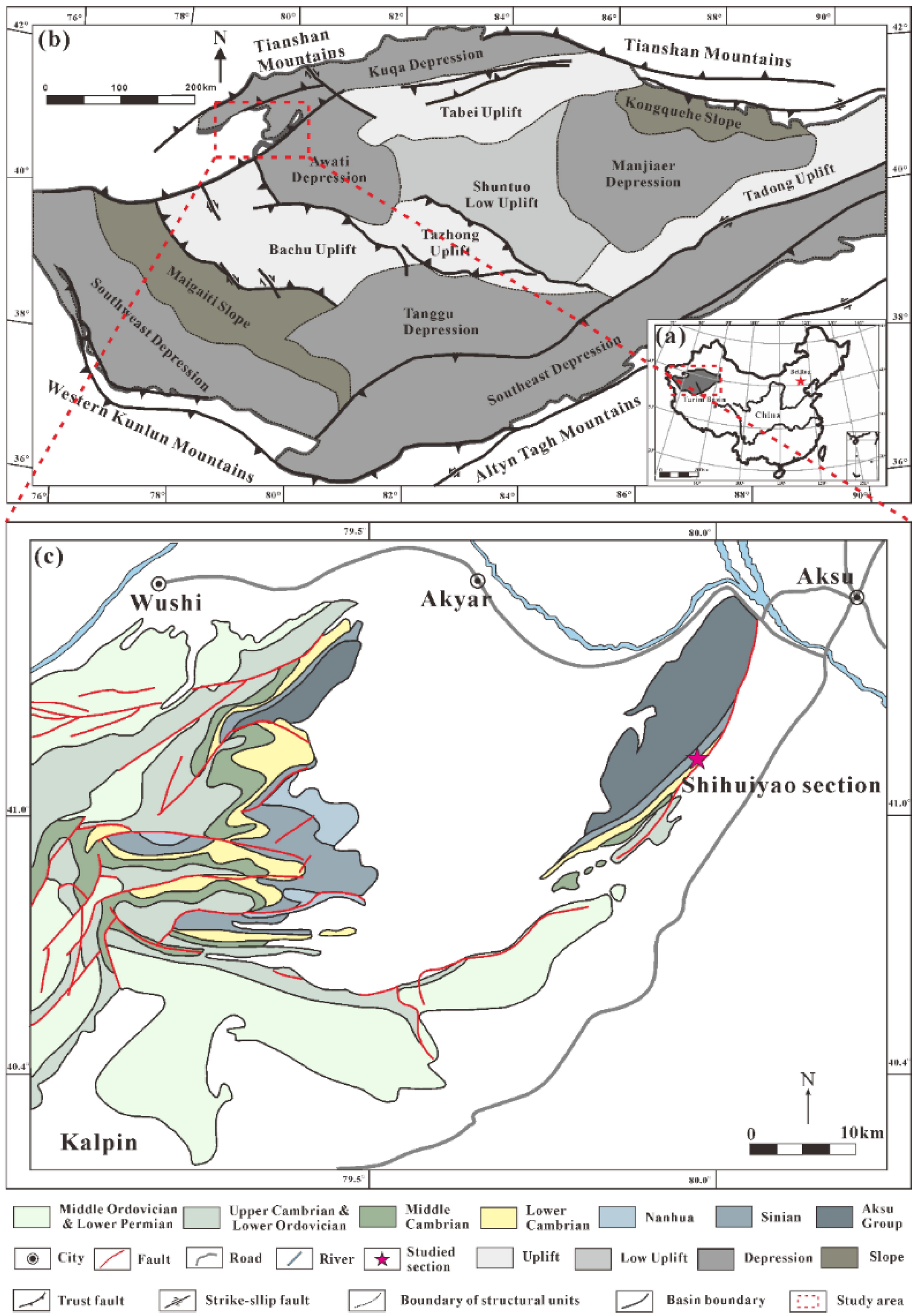
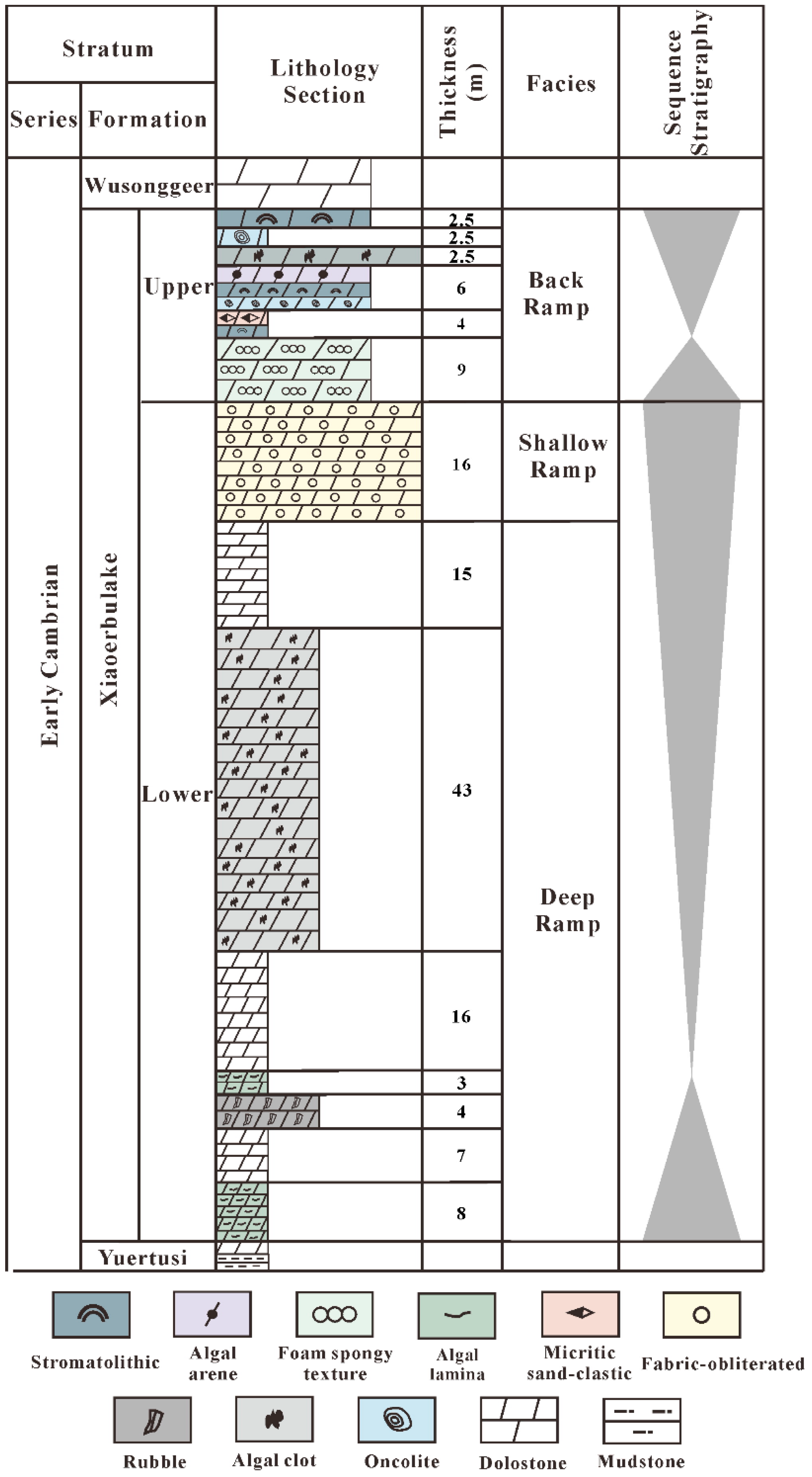
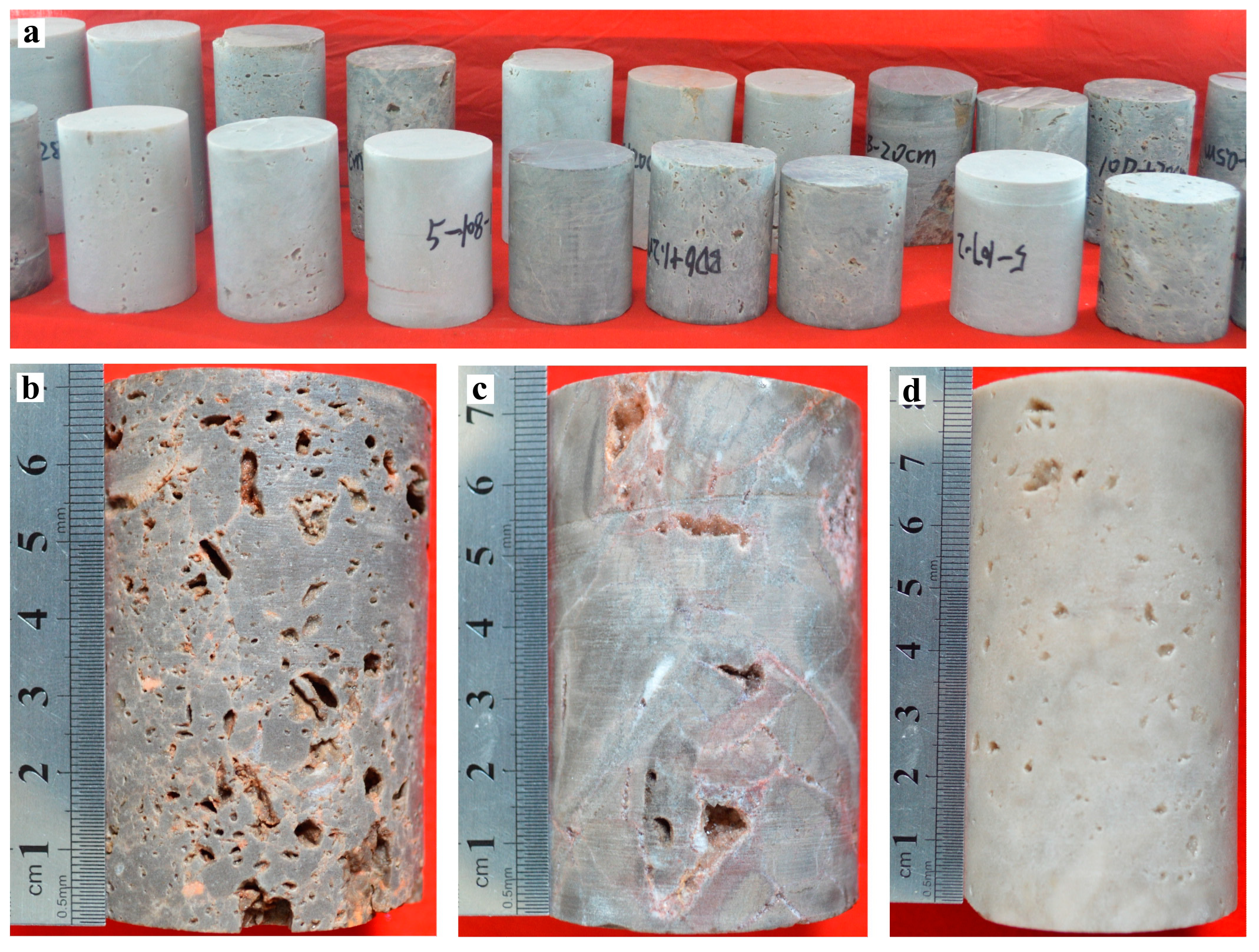
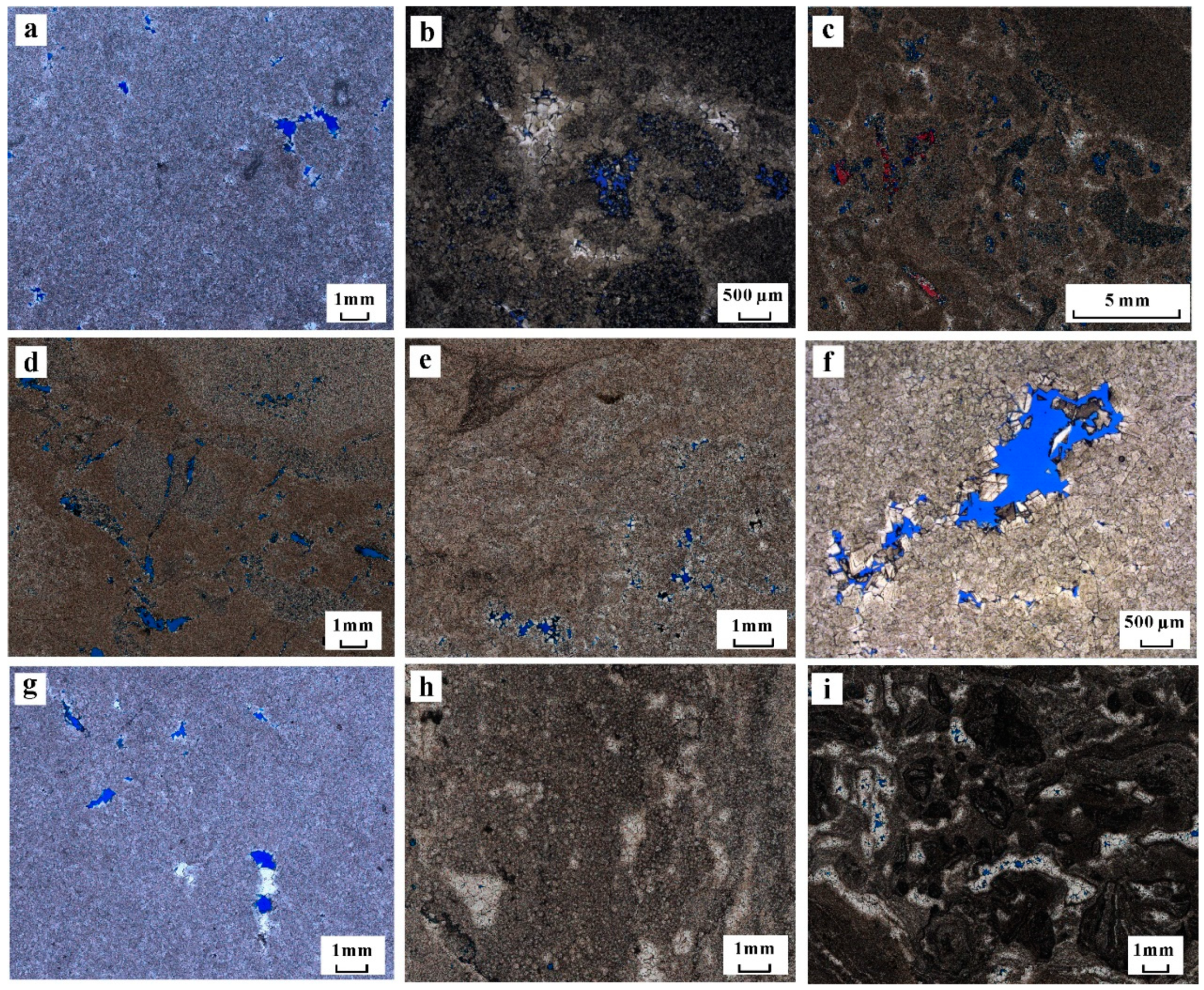
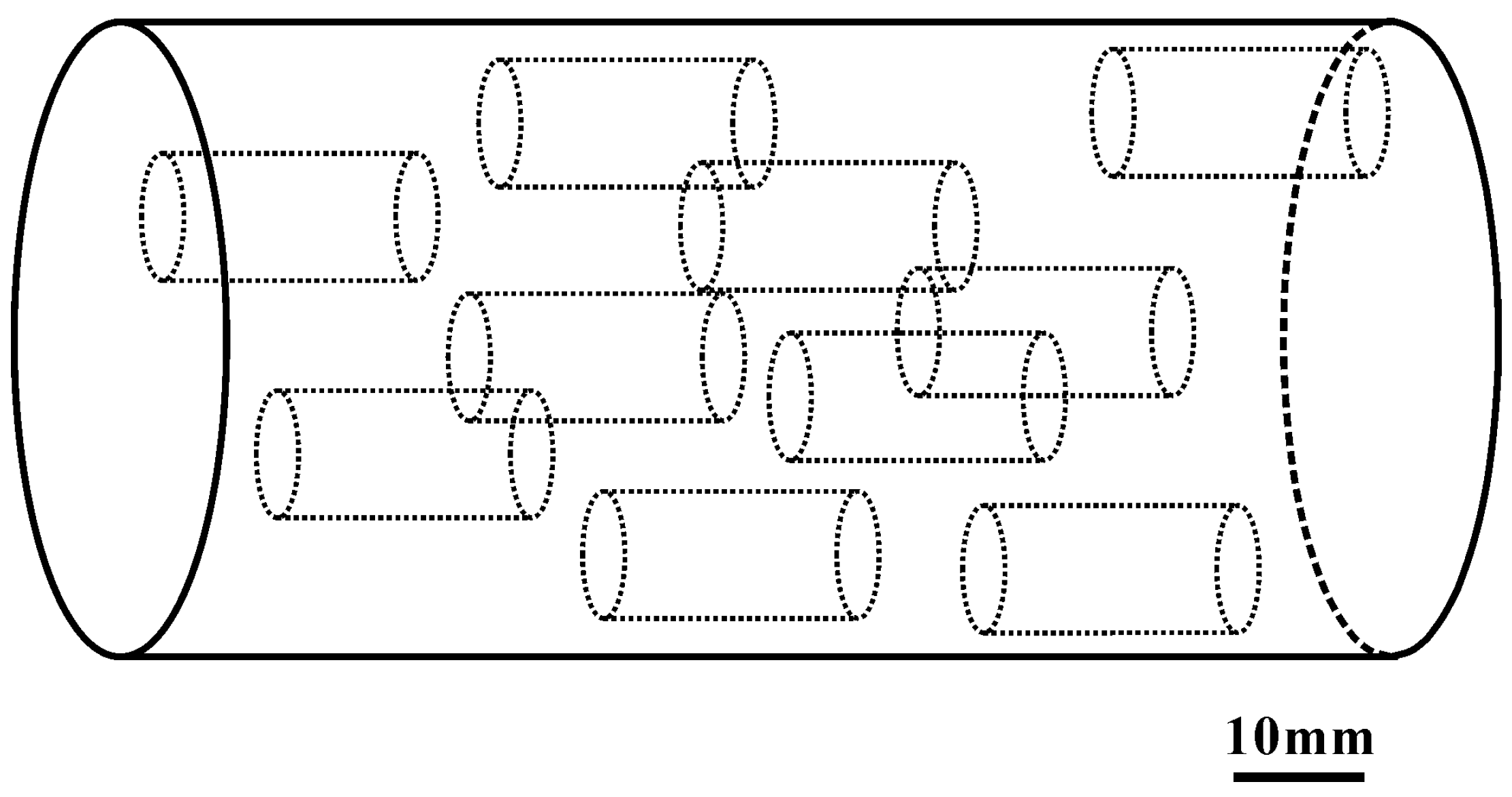
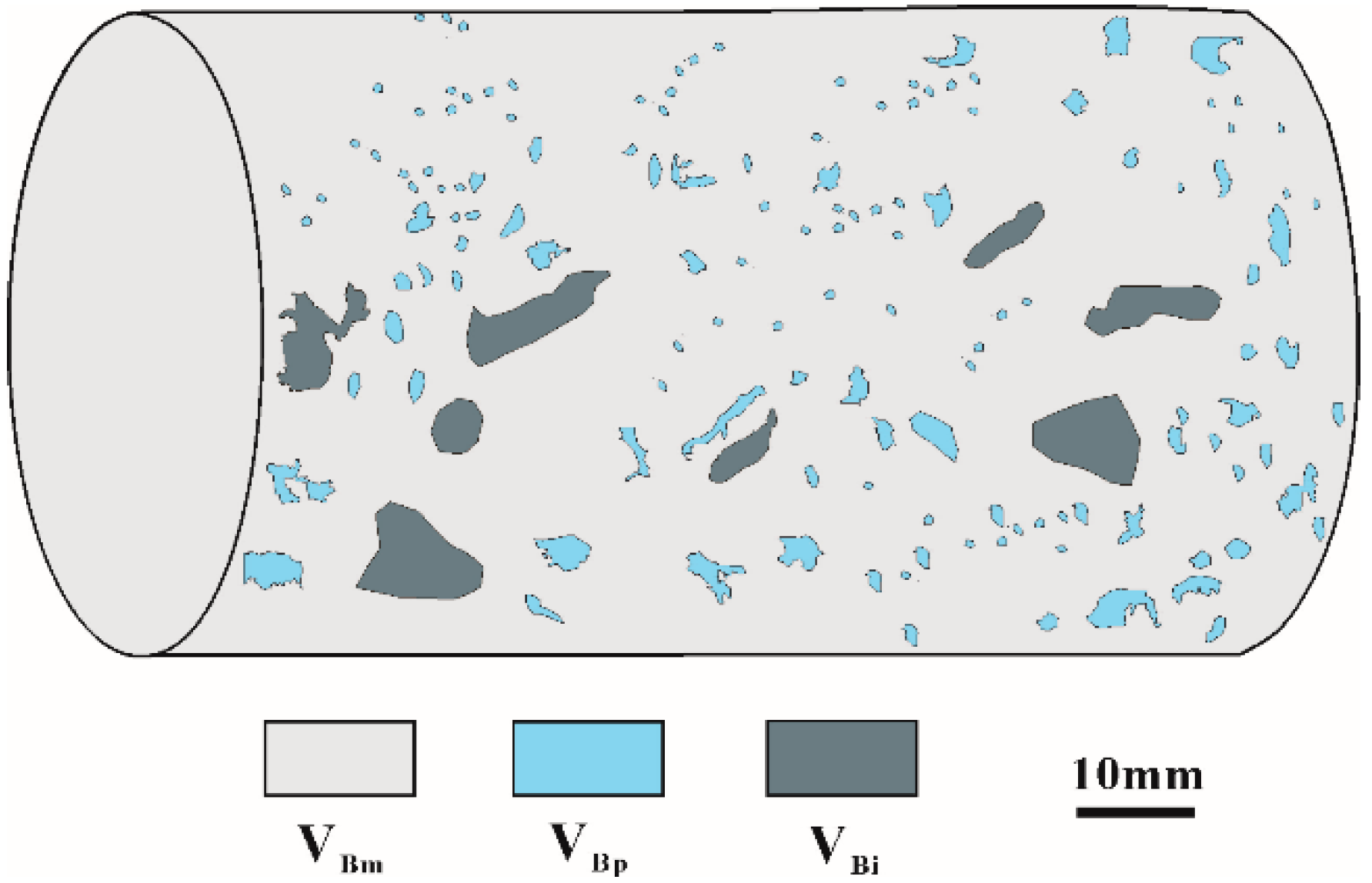
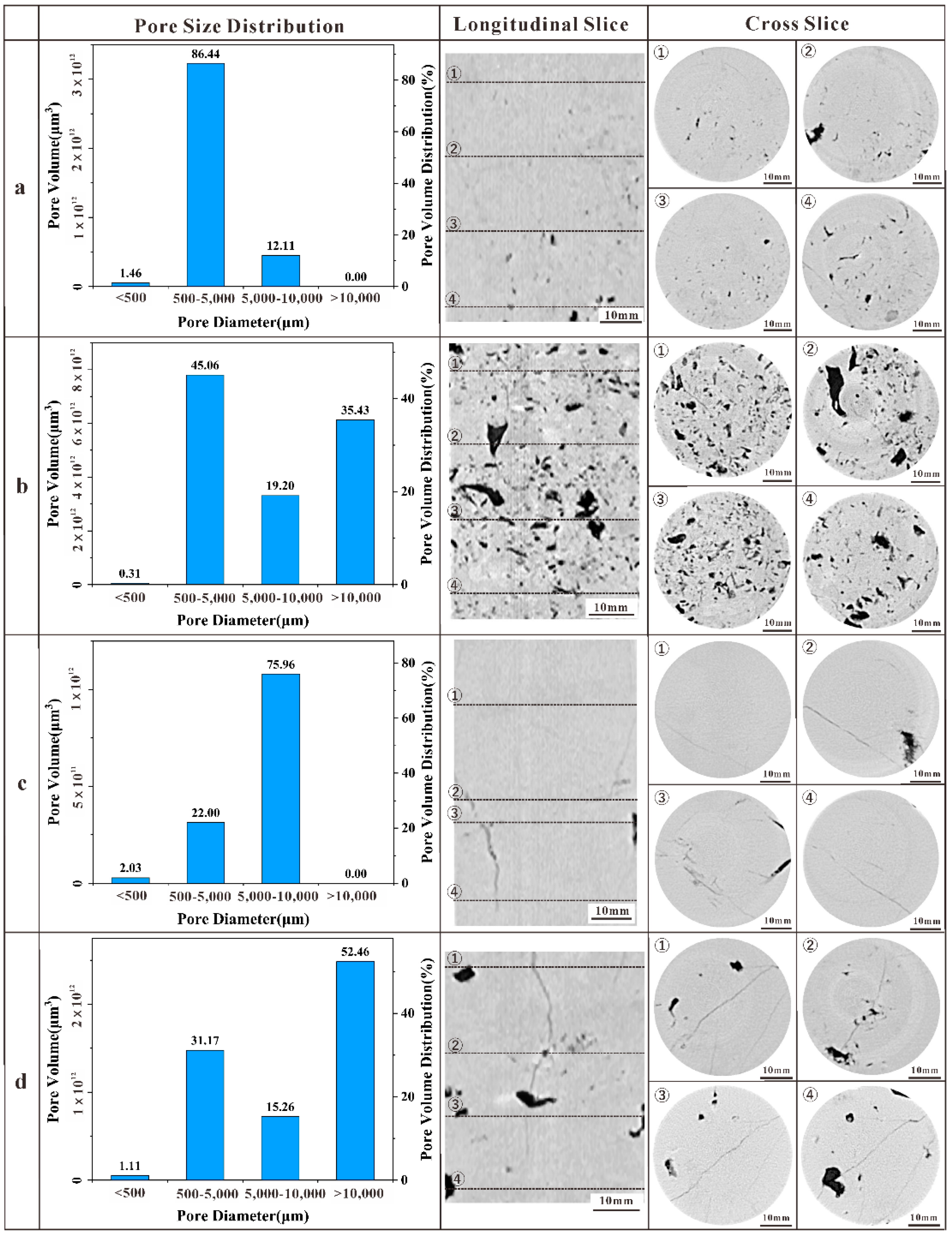
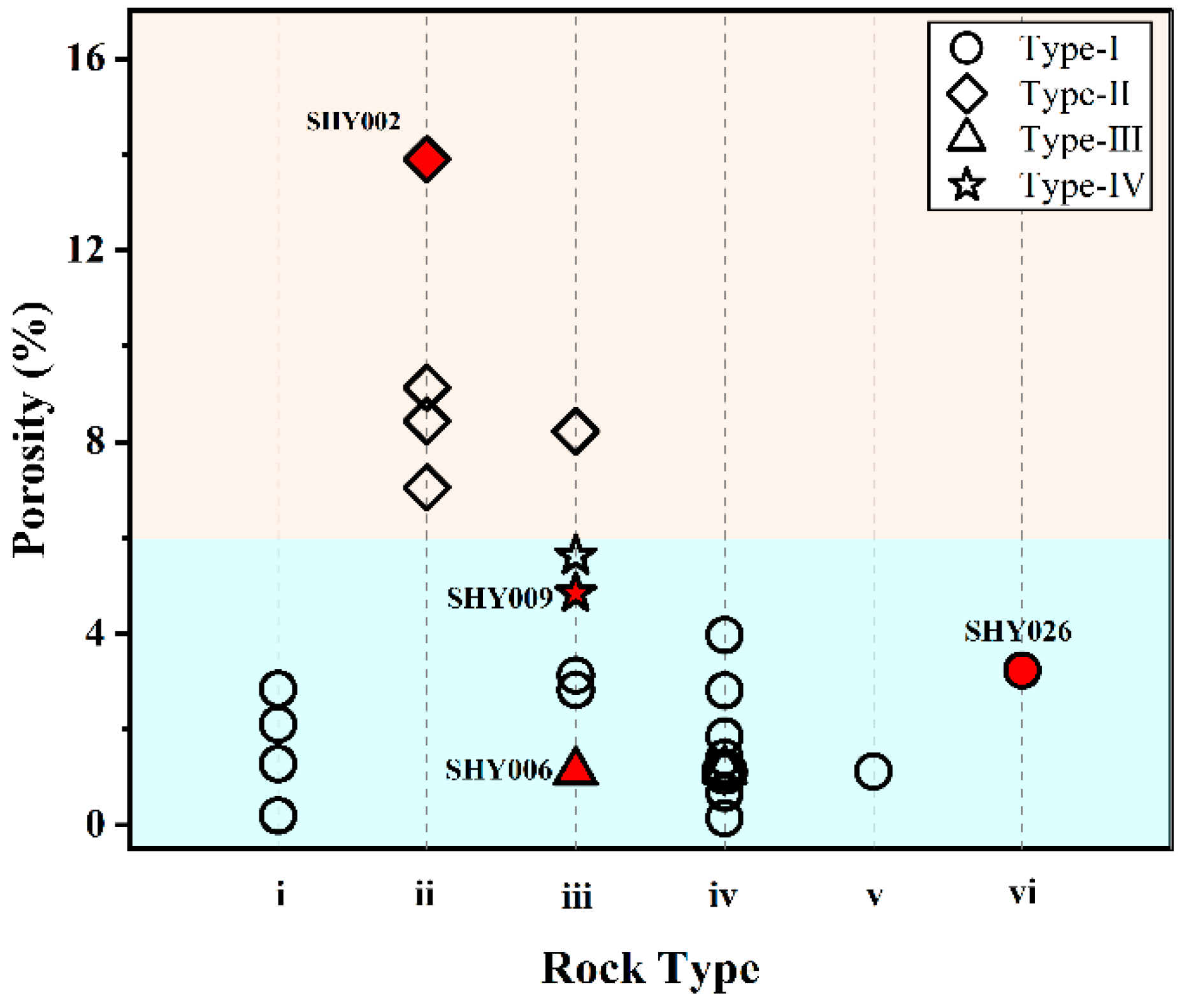
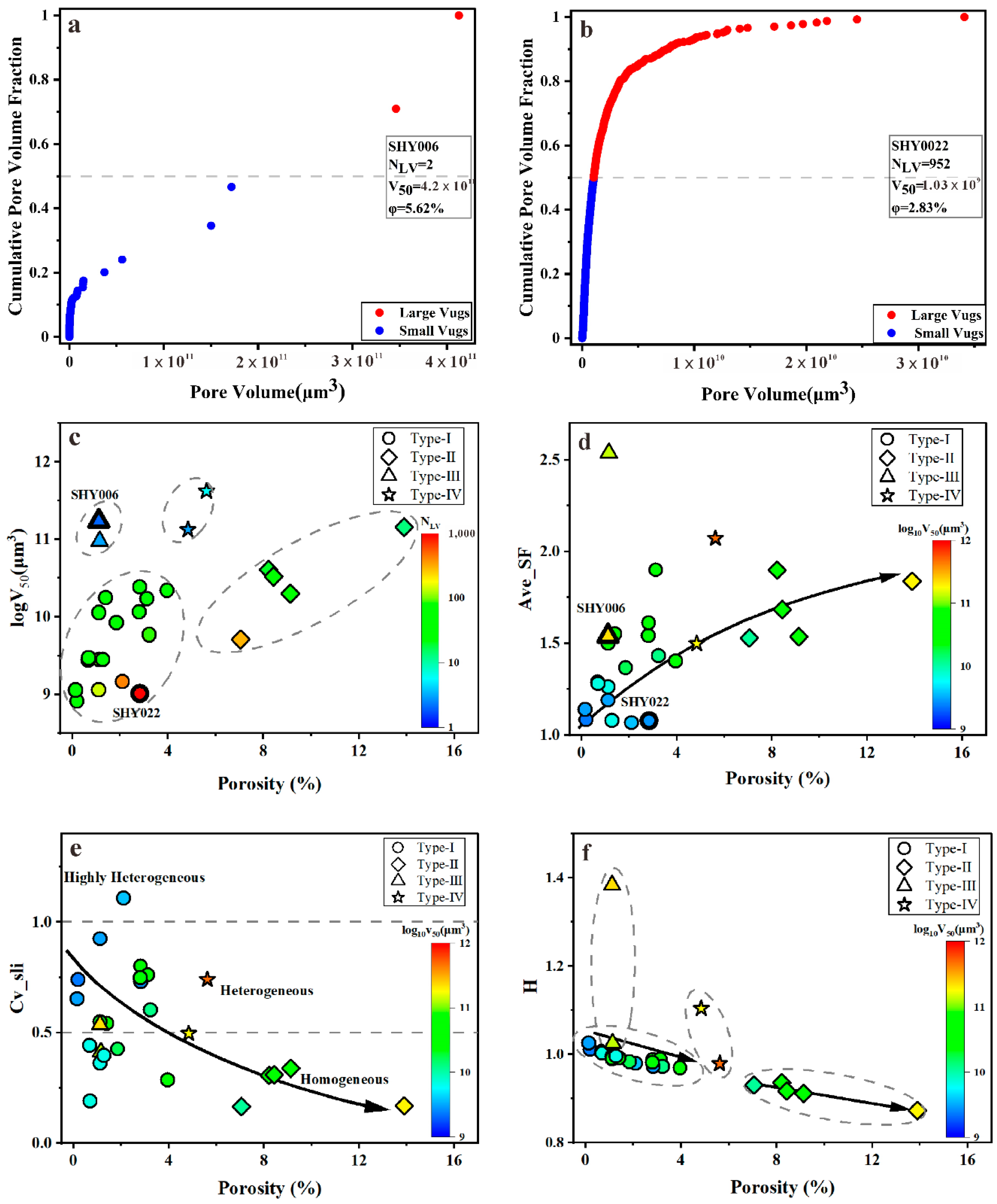

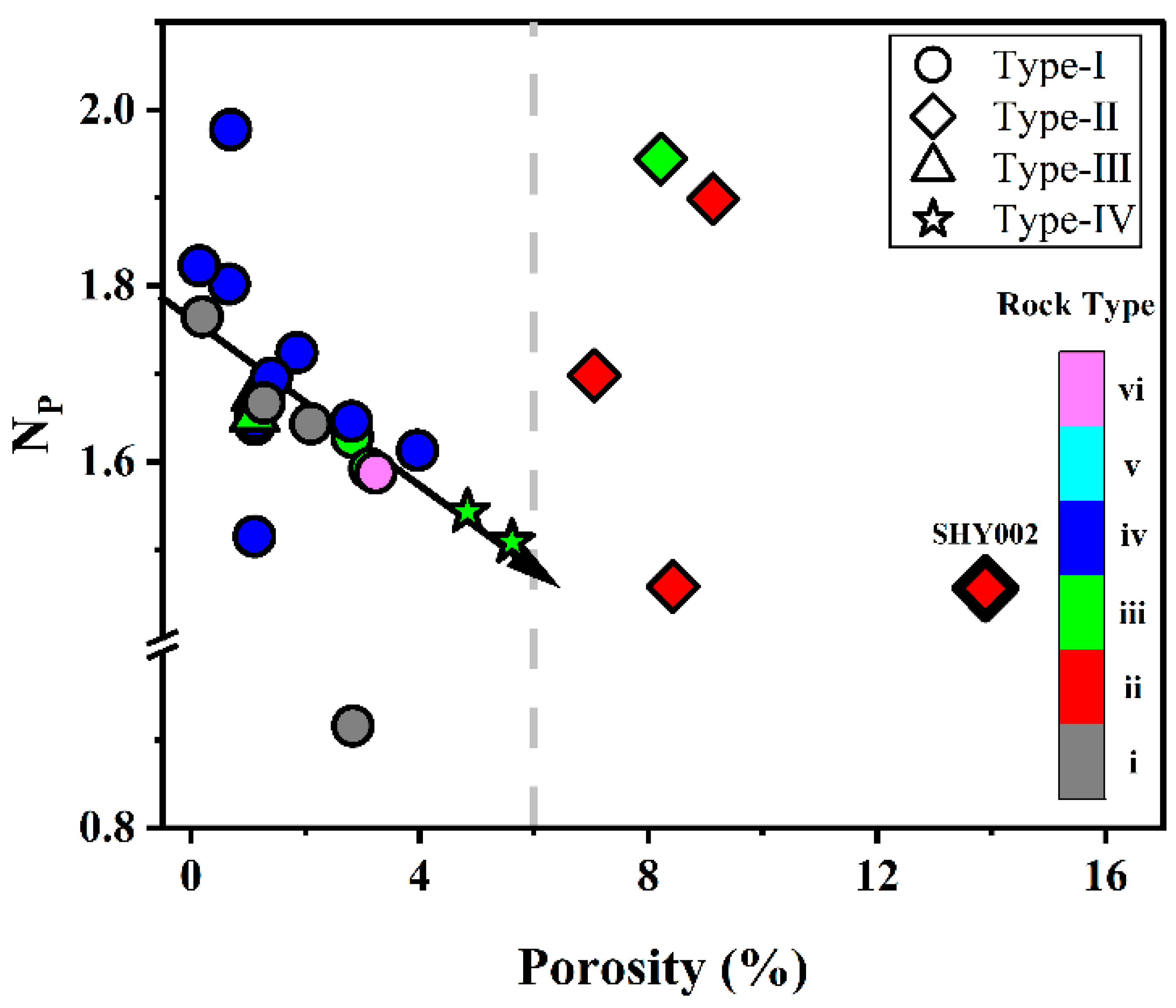
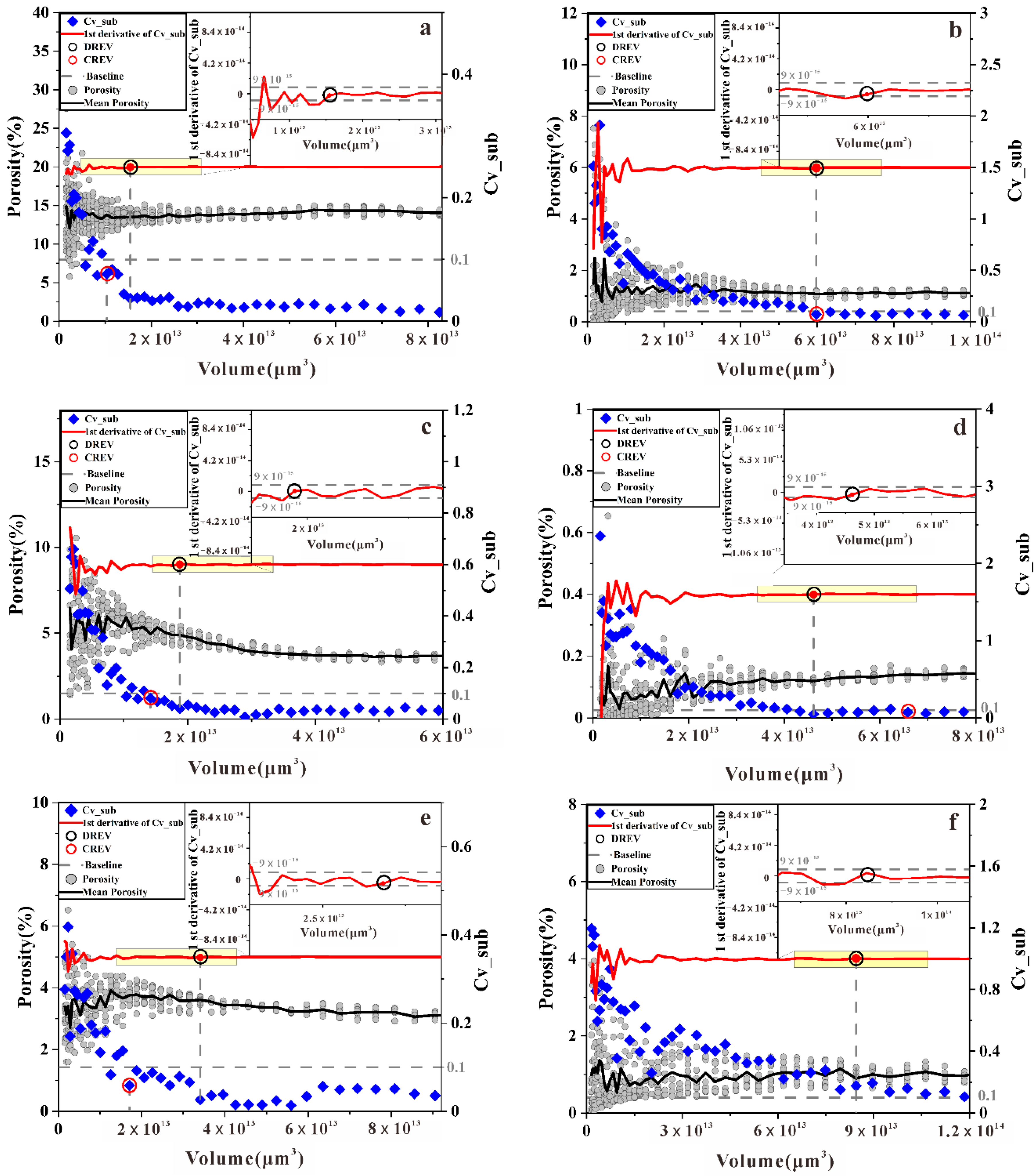
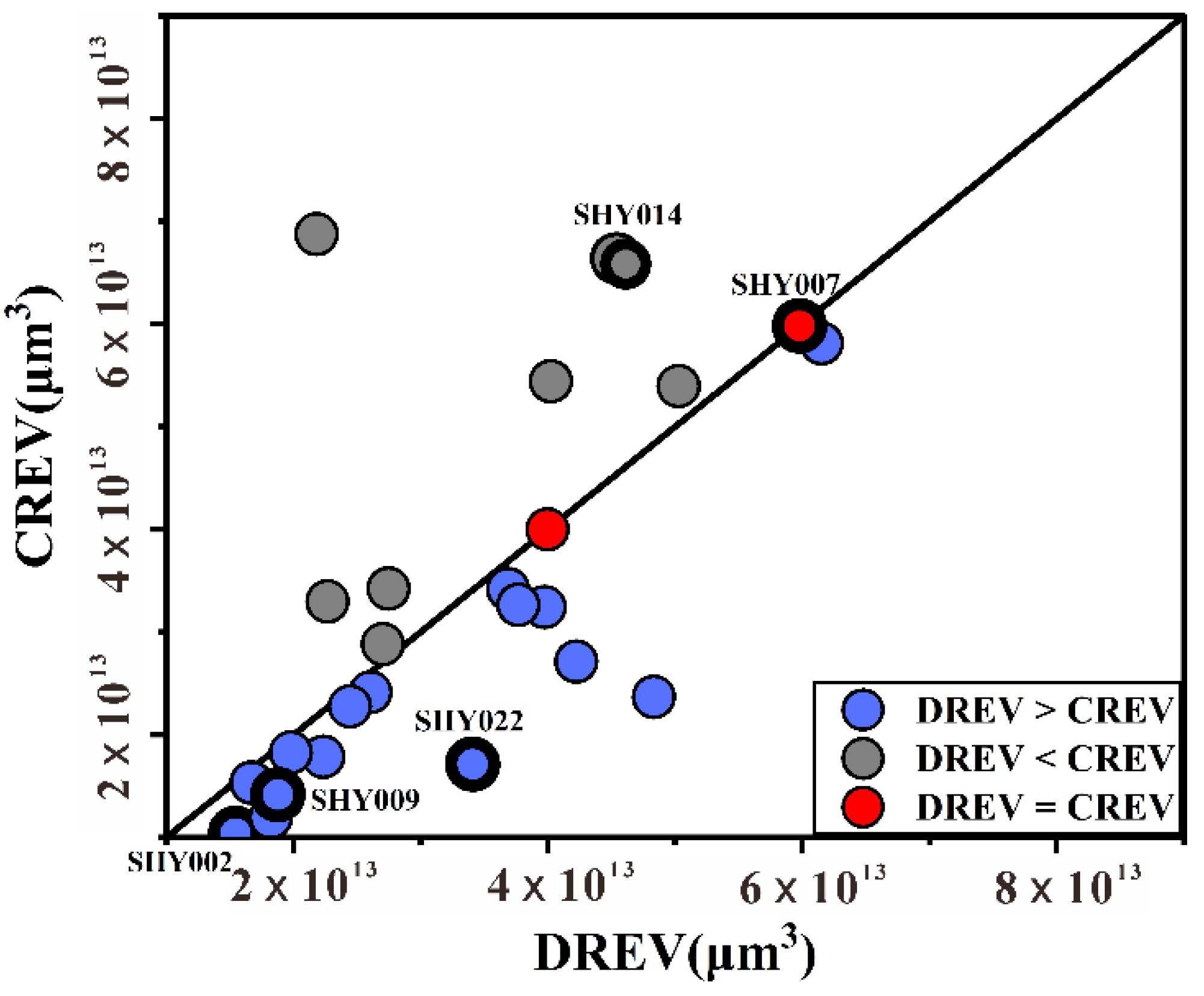
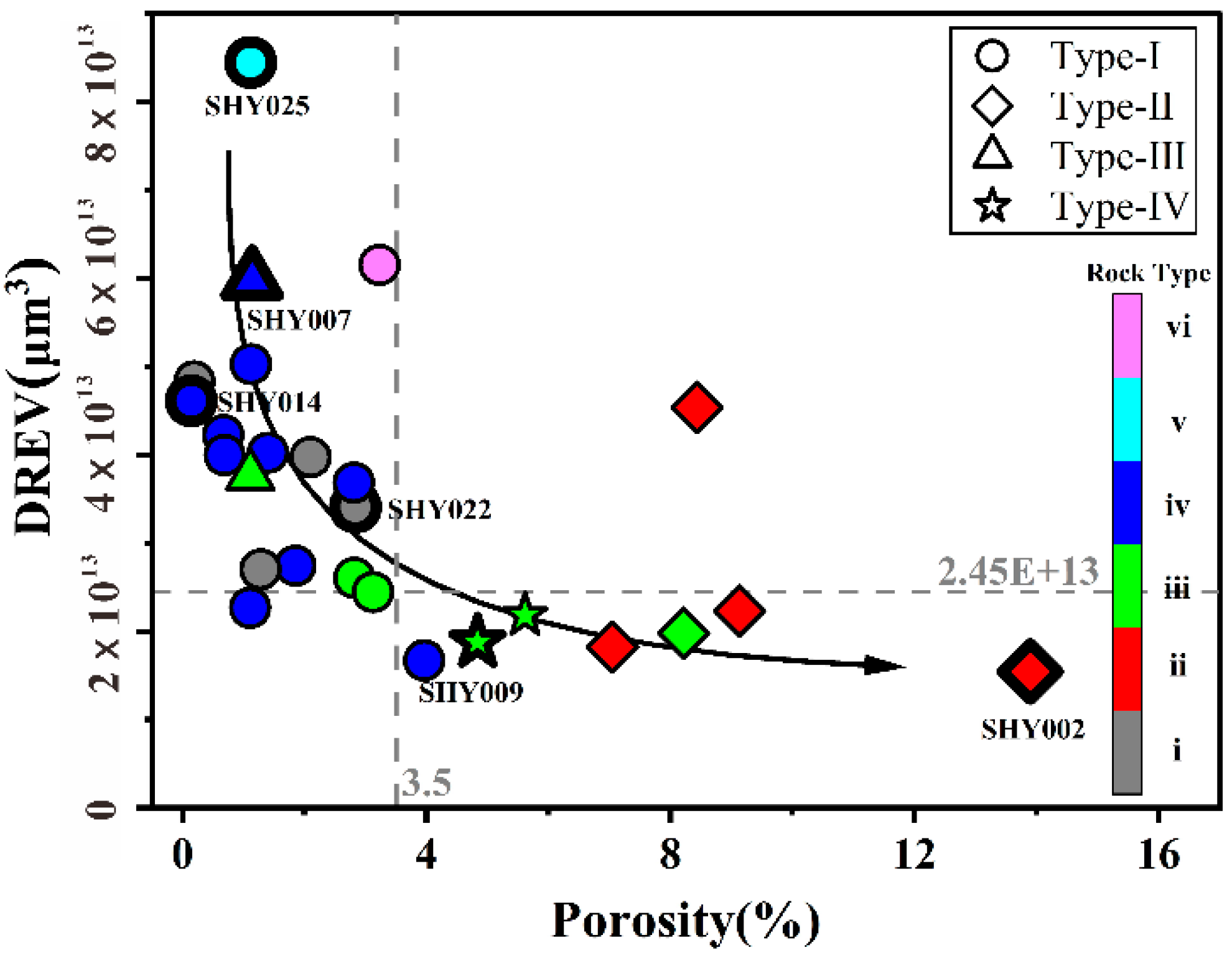
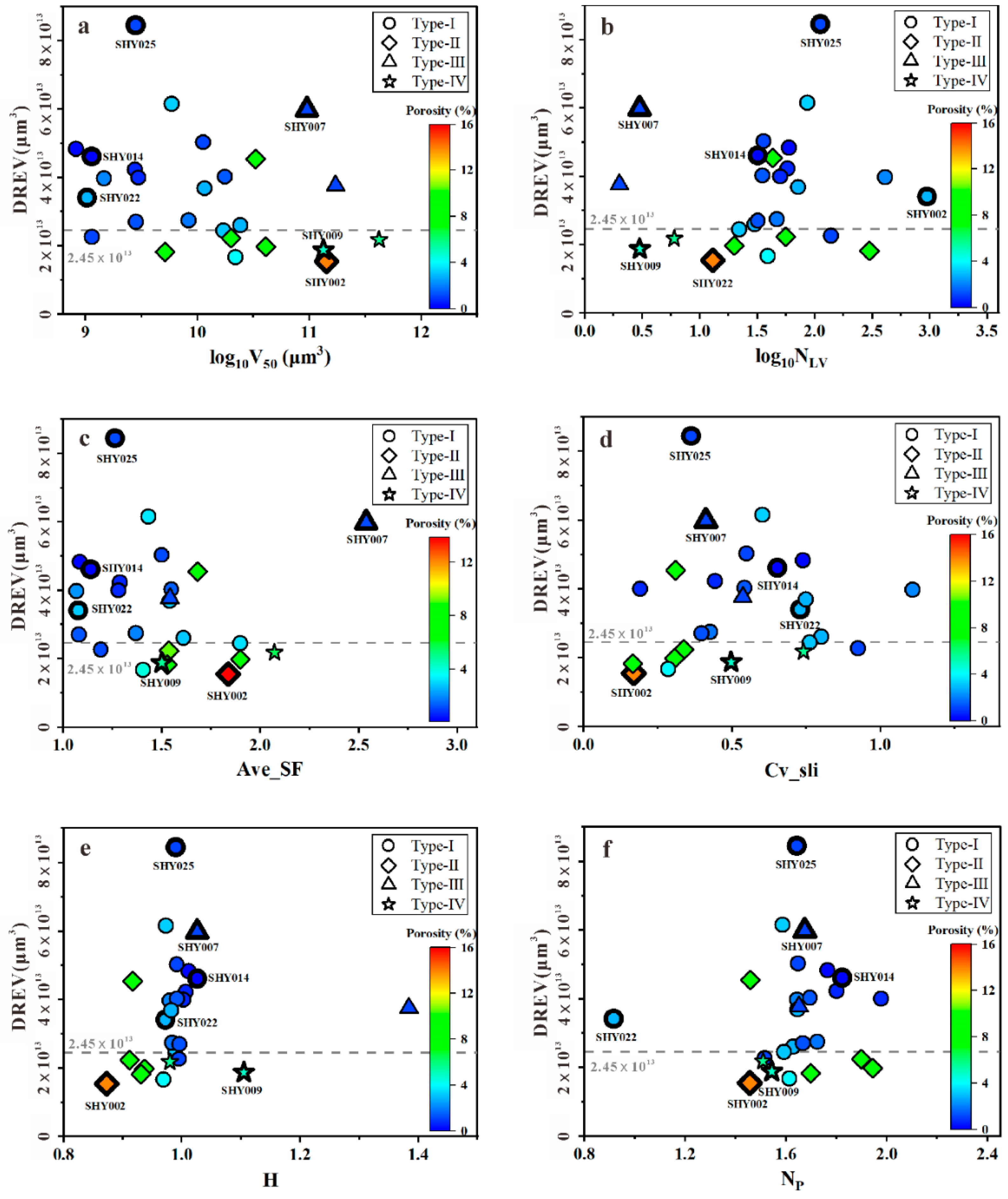

| Sample Name | Pore Type | Porosity (%) | V50 | Ave_SF | Cv | CREV | DREV | ||
|---|---|---|---|---|---|---|---|---|---|
| SHY001 | I | 1.11 | 1.14 × 109 | 139 | 1.19 | 0.92 | 1.00 | 3.30 × 1013 | 2.27 × 1013 |
| SHY002 | II | 13.90 | 1.43 × 1011 | 13 | 1.84 | 0.17 | 0.87 | 1.04 × 1013 | 1.55 × 1013 |
| SHY003 | II | 8.43 | 3.31 × 1010 | 43 | 1.68 | 0.31 | 0.92 | 6.64 × 1013 | 4.54 × 1013 |
| SHY004 | II | 7.05 | 5.14 × 109 | 299 | 1.53 | 0.17 | 0.93 | 1.19 × 1013 | 1.82 × 1013 |
| SHY005 | II | 9.13 | 2.00 × 1010 | 56 | 1.54 | 0.34 | 0.91 | 1.78 × 1013 | 2.23 × 1013 |
| SHY006 | III | 1.11 | 1.72 × 1011 | 2 | 1.54 | 0.54 | 1.38 | 3.27 × 1013 | 3.77 × 1013 |
| SHY007 | III | 1.14 | 9.47 × 1010 | 3 | 2.54 | 0.41 | 1.03 | 5.98 × 1013 | 5.98 × 1013 |
| SHY008 | I | 3.12 | 1.71 × 1010 | 22 | 1.90 | 0.76 | 0.99 | 2.27 × 1013 | 2.44 × 1013 |
| SHY009 | IV | 4.84 | 1.34 × 1011 | 3 | 1.50 | 0.50 | 1.10 | 1.42 × 1013 | 1.88 × 1013 |
| SHY010 | I | 2.82 | 2.42 × 1010 | 30 | 1.61 | 0.80 | 0.99 | 2.41 × 1013 | 2.61 × 1013 |
| SHY011 | II | 8.22 | 4.07 × 1010 | 20 | 1.90 | 0.31 | 0.94 | 1.82 × 1013 | 1.98 × 1013 |
| SHY012 | IV | 5.62 | 4.20 × 1011 | 6 | 2.07 | 0.74 | 0.98 | 6.87 × 1013 | 2.18 × 1013 |
| SHY013 | I | 0.69 | 2.98 × 109 | 50 | 1.28 | 0.19 | 1.00 | 4.00 × 1013 | 4.00 × 1013 |
| SHY014 | I | 0.15 | 1.14 × 109 | 32 | 1.14 | 0.65 | 1.03 | 6.58 × 1013 | 4.61 × 1013 |
| SHY015 | I | 1.12 | 1.13 × 1010 | 36 | 1.50 | 0.55 | 0.99 | 5.39 × 1013 | 5.03 × 1013 |
| SHY016 | I | 2.81 | 1.16 × 1010 | 72 | 1.54 | 0.75 | 0.98 | 3.42 × 1013 | 3.69 × 1013 |
| SHY017 | I | 1.85 | 8.36 × 109 | 47 | 1.37 | 0.43 | 0.98 | 3.42 × 1013 | 2.75 × 1013 |
| SHY018 | I | 1.40 | 1.76 × 1010 | 35 | 1.55 | 0.54 | 0.99 | 5.44 × 1013 | 4.02 × 1013 |
| SHY019 | I | 0.67 | 2.78 × 109 | 58 | 1.29 | 0.44 | 1.01 | 2.71 × 1013 | 4.23 × 1013 |
| SHY020 | I | 1.28 | 2.81 × 109 | 32 | 1.08 | 0.40 | 1.00 | 2.88 × 1013 | 2.70 × 1013 |
| SHY021 | I | 0.20 | 8.21 × 108 | 60 | 1.08 | 0.74 | 1.01 | 2.37 × 1013 | 4.83 × 1013 |
| SHY022 | I | 2.83 | 1.03 × 109 | 952 | 1.08 | 0.73 | 0.97 | 1.71 × 1013 | 3.41 × 1013 |
| SHY023 | I | 3.96 | 2.19 × 1010 | 39 | 1.41 | 0.29 | 0.97 | 1.53 × 1013 | 1.67 × 1013 |
| SHY024 | I | 2.10 | 1.47 × 109 | 409 | 1.07 | 1.11 | 0.98 | 3.24 × 1013 | 3.97 × 1013 |
| SHY025 | I | 1.12 | 2.81 × 109 | 112 | 1.26 | 0.36 | 0.99 | - | 8.45 × 1013 |
| SHY026 | I | 3.23 | 5.89 × 109 | 86 | 1.43 | 0.60 | 0.97 | 5.81 × 1013 | 6.15 × 1013 |
| Dependent Variable | Independent Variables | R2 | p-Value | D-W | |
|---|---|---|---|---|---|
| log(DREV/V50) | (a) | 0.3559 | 0.3290 | 0.0013 | 1.5702 |
| (b) + Cv_sli | 0.3570 | 0.3012 | 0.0062 | 1.5708 | |
| 0.5853 | 0.5492 | 0.0000 | 1.6838 | ||
| 0.5874 | 0.5311 | 0.0002 | 1.6674 | ||
| 0.8195 | 0.7949 | 0.0000 | 1.3571 | ||
| 0.8366 | 0.8054 | 0.0000 | 1.2550 | ||
| 0.8713 | 0.8468 | 0.0000 | 1.4798 | ||
| 0.9429 | 0.9320 | 0.0000 | 1.5530 |
Publisher’s Note: MDPI stays neutral with regard to jurisdictional claims in published maps and institutional affiliations. |
© 2022 by the authors. Licensee MDPI, Basel, Switzerland. This article is an open access article distributed under the terms and conditions of the Creative Commons Attribution (CC BY) license (https://creativecommons.org/licenses/by/4.0/).
Share and Cite
Xue, Y.; Cai, Z.; Zhang, H.; Liu, Q.; Chen, L.; Gao, J.; Hu, F. Insights into Heterogeneity and Representative Elementary Volume of Vuggy Dolostones. Energies 2022, 15, 5817. https://doi.org/10.3390/en15165817
Xue Y, Cai Z, Zhang H, Liu Q, Chen L, Gao J, Hu F. Insights into Heterogeneity and Representative Elementary Volume of Vuggy Dolostones. Energies. 2022; 15(16):5817. https://doi.org/10.3390/en15165817
Chicago/Turabian StyleXue, Yufang, Zhongxian Cai, Heng Zhang, Qingbing Liu, Lanpu Chen, Jiyuan Gao, and Fangjie Hu. 2022. "Insights into Heterogeneity and Representative Elementary Volume of Vuggy Dolostones" Energies 15, no. 16: 5817. https://doi.org/10.3390/en15165817
APA StyleXue, Y., Cai, Z., Zhang, H., Liu, Q., Chen, L., Gao, J., & Hu, F. (2022). Insights into Heterogeneity and Representative Elementary Volume of Vuggy Dolostones. Energies, 15(16), 5817. https://doi.org/10.3390/en15165817




